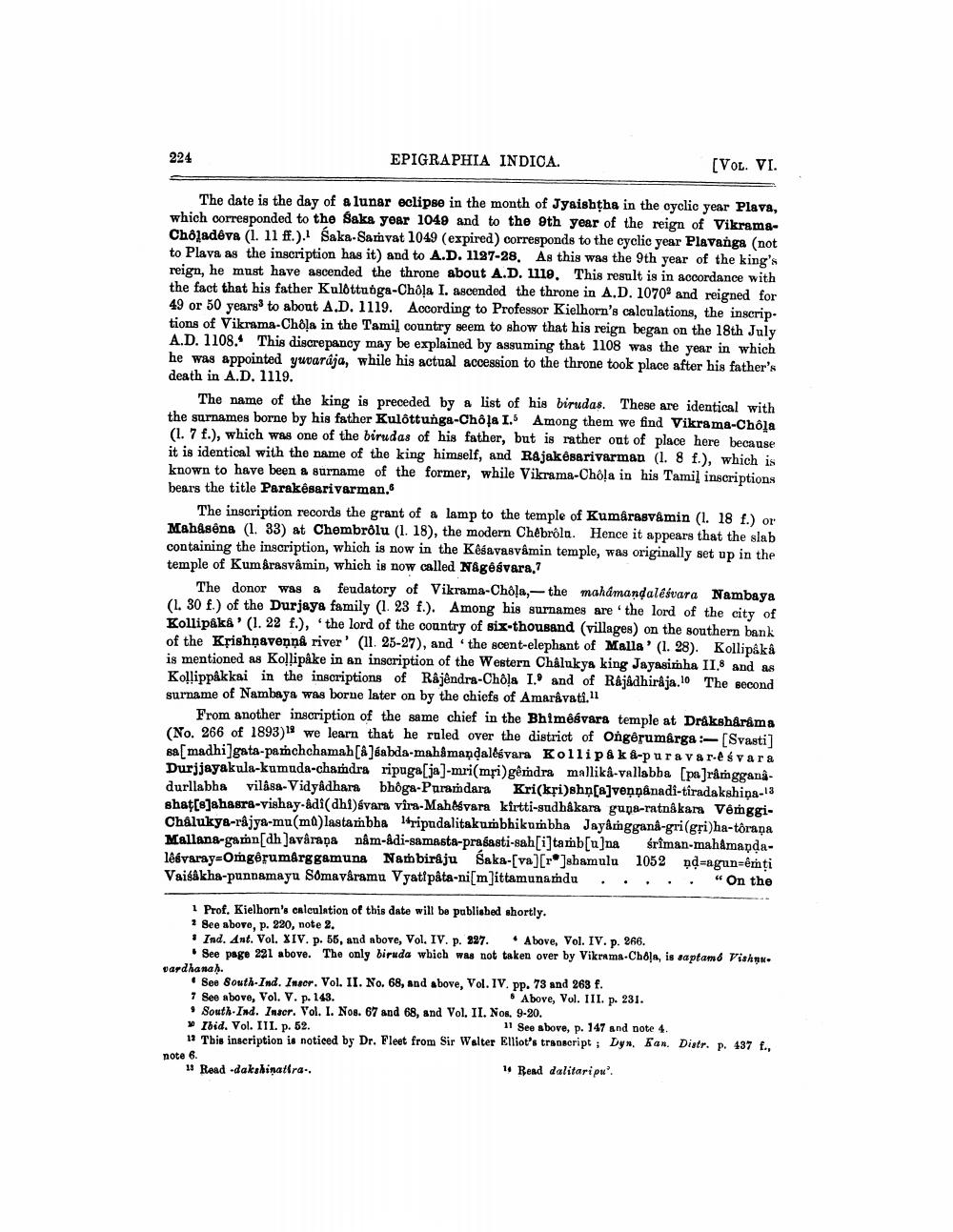________________
224
EPIGRAPHIA INDICA.
[Vol. VI.
The date is the day of a lunar eclipse in the month of Jysishtha in the cyclic year Plava, which corresponded to the Saka year 1049 and to the eth year of the reign of VikramaCholadéva (1. 11 ff.). Saka-Samvat 1049 (expired) corresponds to the cyclic year Plavanga (not to Plava as the inscription has it) and to A.D. 1127-28. As this was the 9th year of the king's reign, he must have ascended the throne about A.D. 1119. This result is in accordance with the fact that his father Kulttunga-Chola I. ascended the throne in A.D. 1070 and reigned for 49 or 50 years to about A.D. 1119. According to Professor Kielhorn's calculations, the inscrip. tions of Vikrama-Chôļa in the Tamil country seem to show that his reign began on the 18th July A.D. 1108. This discrepancy may be explained by assuming that 1108 was the year in which he was appointed ywvaraja, while his actual accession to the throne took place after his father's death in A.D. 1119.
The name of the king is preceded by a list of his birudas. These are identical with the surnames borne by his father Kulôttunga-Chôļa 1.5 Among them we find Vikrama-Chola (1. 7 f.), which was one of the birudas of his father, but is rather out of place here because it is identical with the name of the king himself, and Rajakesarivarman (1. 8 f.), which is known to have been a surname of the former, while Vikrama-Chóļa in his Tamil inscriptions bears the title Parakesarivarman.
The inscription records the grant of a lamp to the temple of Kumarasvåmin (1. 18 f.) or Mahasena (1. 33) at Chembrðlu (1. 18), the modern Chébróla. Hence it appears that the slab containing the inscription, which is now in the Kêśavasyamin temple, was originally set up in the temple of Kum&rasvâmin, which is now called Någesvara,7
The donor was a feudatory of Vikrama-Chôļa,- the mahamandalesvara Nambaya (1. 30 f.) of the Durjaya family (1. 23 f.). Among his surnames are the lord of the city of Kollipaka' (1. 22 f.), the lord of the country of six-thousand (villages) on the southern bank of the Krishṇavenná river' (11. 25-27), and the scent-elephant of Malla' (1. 28). Kollipaka is mentioned as Kollipake in an inscription of the Western Chålukys king Jayasimha II.8 and as Kollippåkkai in the inscriptions of Rajendra-Chola I. and of Rajadhiraja. The second surname of Nambaya was borne later on by the chiefs of Amaravati."
From another inscription of the same chief in the Bhimêsvara temple at Drakshåráma (No. 266 of 1893) we learn that he ruled over the district of Ongêsumarga : [Svasti] samadhi]gata-pamchchamah[a]sabda-mahamandalesvara Kollipa k a-pura vare svara Durjjayakula-kumuda-chandra ripuga [ja]-mri(mri)gêmdra mallika-vallabba [pa]ramggangdurllabha vilâsa-Vidyadhara bhôga-Paramdara Kri(krishn[8]venpånadi-tiradakshiņa-13 shat[e]ahasra-vishay-ádi(dhi)śvara vira-Maheśvara kirtti-sudhakara guna-ratnakara Vêmggi. Chalukya-rajya-mu(mu)lastambha 14ripudalitakumbhikumbha Jayânggana-gri(gri)ha-torana Mallana-garn[dh Javarapa nåm-Adi-samasta-prasasti-sah[i]tamb[u]na Sriman-mahamandalêsyaray-Omgêrumärggamuna Nam biraju Saka-[va][r*]shamulu 1052 nd=agun=émţi Vaisakha-pundamayu Somaváramu Vyatipâta-ni[m]ittamunandu . ... . " On the
1 Prof. Kielhorn's calculation of this date will be published shortly ? See above, p. 220, note 2. • Ind. Ant. Vol. XIV. p. 55, and above, Vol. IV. p. 327. Above, Vol. IV. p. 266.
See page 221 above. The only biruda wbich was not taken over by Vikrama-Chol, is saptamd Vishon. vardhanah.
• Boo South-Ind. Insor. Vol. II No. 68, and above, Vol. IV. pp. 73 and 268 f. 7 See above, Vol. V. p. 143.
Above, Vol. III. p. 231. South-Ind. Inser. Vol. I. Nos. 67 and 68, and Vol. II. Nos. 9-20. » Ibid. Vol. III. p. 52.
11 See above, p. 147 and note 4. 11 This inscription is noticed by Dr. Fleet from Sir Walter Elliot's transcript Dyn, kan. Distr. p. 437 .. note 6. 13 Read .dakshinatira..
1. Read dalitari pu.




